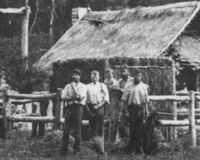Australian Paraguayan
|
New Australia, Paraguay | |
| Total population | |
|---|---|
| 2,000 | |
| Regions with significant populations | |
| Asunción · New Australia | |
| Languages | |
| Paraguayan Spanish · Guaraní · Australian English | |
| Related ethnic groups | |
| Australian diaspora |
Australian Paraguayans are citizens of Paraguay of Australian background. Most of them are descendants of a group of radical socialist Australians who voluntarily went to Paraguay to create a failed master-planned community, known as Nueva (New) Australia.[1]
History
In 1893, a group of Australian shearers fed up with the lack of job opportunities and security were persuaded by a controversial journalist, William Lane, to form the New Australia movement and over 2,000 prospective colonists signed up immediately.[2] Paraguay was eager to offer the Australian colonists 185,000 acres of fertile land. Having lost 90% of its male population only 20 years before in the Paraguayan War the country was desperate for manpower to work the land and re-populate the diminished nation.[3]
The first group, almost entirely men, was meant to set everything up for the thousands who would follow, and create the world’s first great communist city. They secured a ship to Buenos Aires in Argentina and from there the 238 adults and children traveled across the grasslands in the heart of South America to Paraguay, where the national government had granted them land to start their own colony. For a few years, new colonists continued to trickle into both communities from Australia and the UK, but the majority of settlers left, heading back to Australia or to farm work on Patagonian estancias. But, around eight families did remain and to this day 2,000 descendents of those colonists still call Paraguay home.
Present
Many Australian Paraguayans still live in New Australia but they are no longer Communists.[4] They are now firm believers in Capitalism, and according to reports some have become quite large landowners and employing labor.
Notable people
- León Cadogan - Paraguayan ethnologist
- Gilbert Casey - Australian trade unionist
- Mary Gilmore - Australian socialist poet and journalist.
- William Lane - Pioneer of the Australian labour movement and utopian.
- Rose Summerfield - Australian feminist and labour activist.
- Robin Wood - Paraguayan comic book writer
- Alex Sharman - Former Rugby Union player
See also
- Australia–Paraguay relations
- Foreign relations of Australia
- Foreign relations of Paraguay
- Confederados - Brazilians descended from Confederate Americans who fled the United States to Brazil after the American Civil War
References
- ↑ "Cosme and New Australia colonies". National Treasures exhibition. National Library of Australia. Retrieved 2008-10-28.
- ↑ smh.com.au - Australian echoes in Paraguayan paradise
- ↑ The Argentina Independent - New Australia: The Australian Colony in Paraguay
- ↑ PANCE - Australia's Experiment in Communism
| ||||||||||||||||||||
| ||||||
